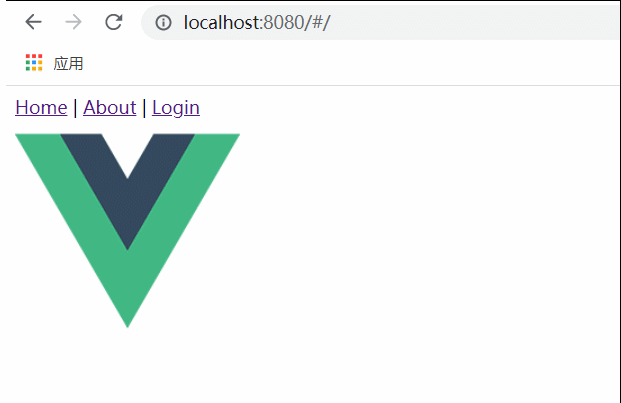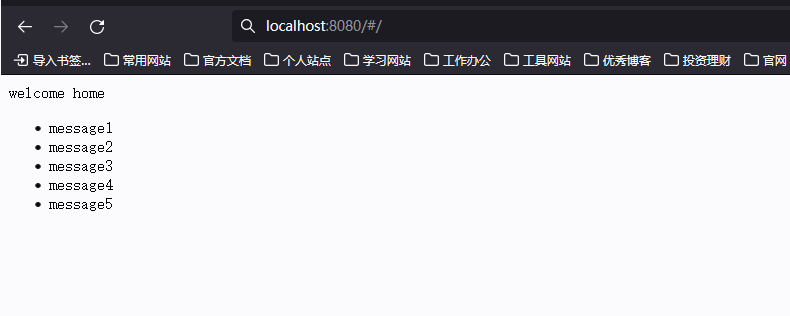文章目录
- 前言
- 一、起步
- 1.1、ES5实现局部页面路由跳转
- 二、通过vue-cli使用vue-router组件
- 2.1、哈希路由
- 三、嵌套路由(示例)
- 四、404页面实现
- 五、进阶
- 5.1、导航守卫
前言
本篇博客是在vue-cli的学习笔记,若文章中出现相关问题,请指出!
- 当前该链接失效了,有需要的小伙伴可以去b站或者技术胖官网去找相应的视频与笔记。
所有博客文件目录索引:博客目录索引(持续更新)
一、起步
1.1、ES5实现局部页面路由跳转
目的:单页面中实现局部路由跳转
<html lang="en">
<head>
<meta charset="UTF-8">
<meta http-equiv="X-UA-Compatible" content="IE=edge">
<meta name="viewport" content="width=device-width, initial-scale=1.0">
<title>Document</title>
<!-- 引入vue以及vue-router的js文件 -->
<script src="https://unpkg.com/vue/dist/vue.js"></script>
<script src="https://unpkg.com/vue-router/dist/vue-router.js"></script>
</head>
<body>
<!-- 定义挂载点 -->
<div id="app">
<h1>Hello App!</h1>
<p>
<!-- router-link标签:表示跳转的路径对应着 -->
<router-link to="/foo">Go to Foo</router-link>
<router-link to="/bar">Go to Bar</router-link>
</p>
<!-- 路由出口:与路由匹配的组件将在此处渲染,直接会替换掉该标签(默认渲染第一个路由组件) -->
<router-view></router-view>
</div>
<script>
//1、定义route(路由组件),可被导出到其他文件
const Foo = { template: '<div>foo</div>' }
const Bar = { template: '<div>bar</div>' }
//2、定义一些路由(数组存储对象形式),每一个路由需要对应者一个组件,这些组件可通过示例对象创建如:Vue.extend()或对象组成组件(如上面的{template:xxx}对应)
//之后再来介绍嵌套路由
const routes = [
{ path: '/foo', component: Foo },
{ path: '/bar', component: Bar }
]
//3、可通过new VueRouter来创建实例,可以传入多个选项,这里就传入路由数组即可
const router = new VueRouter({
routes // short for `routes: routes`
})
//4、创建并挂载vue实例,确保要将路由实例进行注入能够得到感知
const app = new Vue({
router
}).$mount('#app')
</script>
</body>
</html>

二、通过vue-cli使用vue-router组件
2.1、哈希路由
构建项目
step1:创建vue-cli,输入vue create xxx
step2:选择手动勾选项目,添加router组件。


哈希路由分析
哈希路由:根据url的不同展示内容不同。
- /#/xxx,其中xxx不同当前页面会根据指定的router标签来进行页面的局部刷新。
异步路由理解:只有当访问指定异步路由组件的时候才进行资源的引入加载操作!一般的话都会直接先去加载!
- 示例:
component: () => import(/* webpackChunkName: "about" */ '../views/About.vue')

router/index.js:路由配置js文件
import { createRouter, createWebHashHistory } from 'vue-router'
import Home from '../views/Home.vue'
import Login from '../views/Login.vue'
// 定义路由规则,url对应组件
const routes = [
{
path: '/',
name: 'Home',
component: Home
},
{
path: '/about',
name: 'About',
// 异步路由
component: () => import(/* webpackChunkName: "about" */ '../views/About.vue')
},
{
path: '/login',
name: 'Login',
component: Login
},
]
// 创建路由
const router = createRouter({
history: createWebHashHistory(),
routes
})
export default routermain.js:使用路由

核心文件:App.vue
<template>
<div id="nav">
<!-- 路径跳转,to指定路由规则中的path,当点击时对应的component组件在router-view标签中显示 -->
<router-link to="/">Home</router-link> |
<router-link to="/about">About</router-link> |
<router-link to="/login">Login</router-link>
</div>
<router-view />
</template>
<style>
</style>

三、嵌套路由(示例)
当我们有多页面时,就可以使用到嵌套路由。

此时我们在App.vue设置一个router-view,其他单独的页面中再嵌套router-view,就能够实现多页面的效果了。(实际上还是单页面,只不过进行了局部刷新罢了)

App.vue:源头,单页面
<template>
<div id="nav">
<router-view />
</div>
</template>
<script>
export default {
name: "App",
components: {},
methods: {
linktoHome() {
this.$router.push("/home");
},
linktoAbout() {
this.$router.push("/About");
},
},
};
</script>
<style>
</style>
应用于App.vue的about、home:其中about.vue与home.vue你就可以看成是两个页面
router/index.js:路由配置
import { createRouter, createWebHashHistory } from 'vue-router'
import Home from '../views/home/Home.vue'
import message from '../views/about/components/message.vue'
import banner from '../views/about/components/banner.vue'
import news from '../views/home/components/news.vue'
const routes = [
{
path: '/',
redirect: '/home'
},
{
path: '/home',
name: 'Home',
component: Home,
children: [
{ path: '/home/message', component: message }
]
},
{
path: '/about',
name: 'About',
component: () => import(/* webpackChunkName: "about" */ '../views/about/About.vue'),
children: [
{ path: '/about/news', component: news },
{ path: '/about/banner', component: banner }
]
}
]
const router = createRouter({
history: createWebHashHistory(),
routes
})
export default routerhome目录:
Home.vue
<template>
welcome home
<router-view />
</template>
<script>
export default {
name: "Home",
components: {},
mounted() {
this.$router.push("/home/message");
},
};
</script>
news.vue:应用于Home.vue
<template>
<div>
<ul>
<li>news1</li>
<li>news2</li>
<li>news3</li>
<li>news4</li>
<li>news5</li>
</ul>
</div>
</template>
<script>
export default {
name: "news",
};
</script>
<style>
</style>
about目录:
About.vue
<template>
welcome about
<el-button type="danger" @click="handleclick">点我一下</el-button>
<router-view />
</template>
<script>
export default {
name: "About",
components: {},
mounted() {
this.$router.push({
path: "/about/news",
query: {
name: "changlu",
age: 18,
},
});
console.log(this.$route);
},
methods: {
handleclick() {
this.$router.push("/about/banner");
},
},
};
</script>
<style>
</style>
应用于About.vue的两个局部组件:
message.vue
<template>
<div>
<ul>
<li>message1</li>
<li>message2</li>
<li>message3</li>
<li>message4</li>
<li>message5</li>
</ul>
</div>
</template>
<script>
export default {
name: "message",
};
</script>
<style>
</style>
banner.vue
<template>
<el-carousel indicator-position="outside">
<el-carousel-item v-for="item in 4" :key="item">
<h3>{{ item }}</h3>
</el-carousel-item>
</el-carousel>
</template>
<script>
export default {
name: "banner",
};
</script>
<style>
.el-carousel__item h3 {
color: #475669;
font-size: 18px;
opacity: 0.75;
line-height: 300px;
margin: 0;
}
.el-carousel__item:nth-child(2n) {
background-color: #99a9bf;
}
.el-carousel__item:nth-child(2n + 1) {
background-color: #d3dce6;
}
</style>

此时就能够实现多页面!
四、404页面实现
添加一个404组件:

router/index.js:进行路由配置
{
path: "/404",
name: "notFound",
component: notfound
},
//匹配没有配置的路由路径
{
path: "/:pathMatch(.*)",
redirect: '/404'
}五、进阶
5.1、导航守卫
导航守卫
全局前置守卫:一般用于全局,每次跳转一个路由都会触发
// 路由守卫
router.beforeEach((to, from, next) => {
const isLogin = localStorage.isLogin //一般是否登陆验证信息放置在localstorage中
// to.name === 'Login'是为了防止拦截死循环!
if (isLogin || to.name === 'Login') {
next() // 执行了该函数才会进行跳转
} else {
// 跳转至指定login组件
next({ name: 'Login' })
}
})

路由独享守卫:针对于某个路由
{
path: '/',
name: 'Login',
component: Login,
beforeEnter: (to, from, next) => { //若是能够登陆直接进行跳转主页
const { isLogin } = localStorage
isLogin ? next({ name: 'About' }) : next()
}
},组件内的守卫:针对于某个组件
全局后置钩子:路由跳转之后
我是长路,感谢你的耐心阅读。如有问题请指出,我会积极采纳!
欢迎关注我的公众号【长路Java】,分享Java学习文章及相关资料
Q群:851968786 我们可以一起探讨学习
注明:转载可,需要附带上文章链接





















